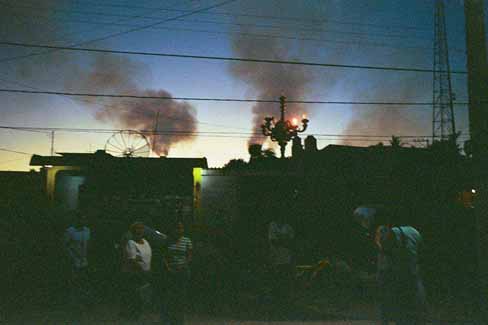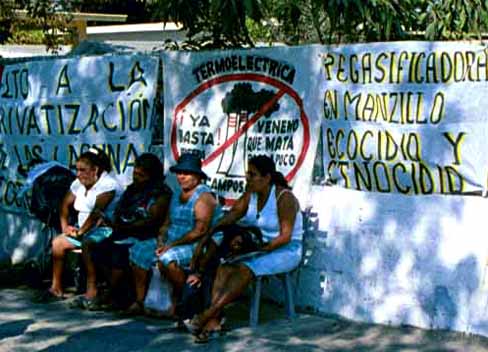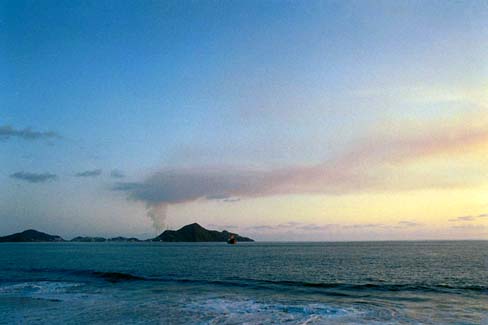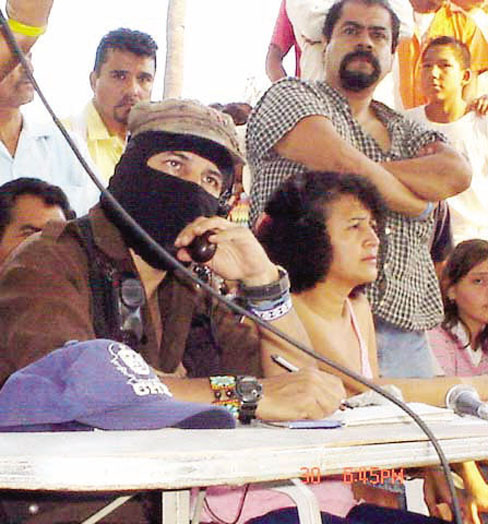The view south-east across the bay from the hills of Las Hadas, the hotel zone in Manzanillo is especially beautiful in the evening as the sun sets and the white painted hotels and restaurants stretching for several miles sparkle in the sun, behind the curving beach. It’s a major Pacific port for Mexico and has grown quickly in recent years under globalization and tourism. Large container ships, bulk carriers from all over the world, and massive cruise ships come and go from the port.
Click on the photo for a larger view.
Photo by Jess MacKenzie and Ernest Tate
But on a clear day, above the low hills towards the far end of the bay, just above the “centro-historico,” a large white plume can be seen rising into the sky, forming small cumulous-like clouds which drift most days slowly over the city. A tourist can be forgiven for thinking this is from a volcano, one of many in Mexico. But it isn’t. It’s the combustion gases from the stacks of two large thermal-electric generating plants, almost hidden behind the hills, and depending upon wind direction, they give an unpleasant yellow hue to the air above this community which promotes itself as “the Mexican Riviera.”
Click on the photo for a larger view.
Photo by Jess MacKenzie and Ernest Tate
We were to learn that the electricity plants — constructed and operated by Federal Electricity Commission (CFE), the state-controlled electricity system — are located next to the fishing and farming village of Campos, the residents of which, along with surrounding communities, have been fighting CFE for years because of the environmental catastrophe caused by the discharges from its plants. Now these communities are confronting an even deeper crisis. For centuries, local fishermen have depended upon the local lagoons — such as the 7,200-hectare Laguna de Cuyutlán, described as an “eco-paradise” in tourist brochures — as a source of livelihood, but these waters, which already have suffered serious pollution because of toxic fallout from the plants, are threatened with even greater devastation when a project by a large Spanish multi-national, Zeta Gas, gets underway, to build in the area a huge facility for the transformation of liquid natural gas back into normal gas and the production of butane. According to Bio Iguana, an environmental non-governmental organization, twenty gigantic storage tanks have already been constructed to store gas. The area — which includes two other lagoons — is to be turned into an industrial corridor, a U.S. two billion-dollar investment, with the excavation of a deep canal to allow the entry of large oceangoing tankers. Local activists say that coastal wet-lands and the lagoons’ fragile eco-systems will be destroyed and that thousands of farming and fishing families will be displaced.
Click on the photo for a larger view.
Photo by Jess MacKenzie and Ernest Tate
We were quite surprised one morning to learn from the local paper, El Noticiero, that, in Campos, on Thursday, March 30th, there would be a community rally for Ejército Zapatista de Liberación Nacional (EZLN)’s leader, Sub-comandante Marcos, a half-way point on his tour of the country, consisting of some forty meetings, concluding on June 25th in Mexico City. A twenty-vehicle caravan would be in Campos, El Noticiero said, to express solidarity with David Diaz Valdez, a fishing cooperative and community leader, recently released from jail after having chained himself to the fence of the CFE plant during a protest. We thought it would be an excellent opportunity to learn more about the EZLN’s “La Otra Campaña,” its new political and organizational offensive directed to all thirty-one states of Mexico which it had launched on January 2nd, the exact day of the Zapatista-led uprising in Chiapas twelve years ago when it first came to the attention of the world with its clarion call for resistance to globalization. With his proposals at the time for new methods of self-government and autonomy for thirty-two indigenous communities, Marcos and the EZLN had captured the imagination of the anti-globalization movement and much of the left. We decided to make our way there.
We also wanted to hear what Marcos would say about the current Mexican presidential campaign, in this “season of protest,” and to see on the ground, so to speak, how it related to the EZLN’s strategy for building “an alliance with the non-electoral left in Mexico who want to build from below.” The EZLN’s “Sixth Declaration” (known in Mexico as the “Sexta”), which forms the basis of “La Otra Campaña” and was adopted last year by a broad coalition of left and activists groups (and open to “non-registered political parties”), denounced all three major capitalist parties for being in the service of neo-liberalism, and attacked the Partido de la Revolución Democrática (PRD) very sharply for its betrayal of the San Andreas Accords (negotiated with the President Vicente Fox to give some autonomy to indigenous communities). The Zapatistas have also declared their solidarity with Cuba and Venezuela’s Bolivarian Revolution.
In his debate with some on the left who have urged him to support the PRD’s candidate, Andrés Manuel López Obrador, Marcos has said that López Obrador speaks with two tongues — one for the popular movements, seemingly to agree with many of their demands, and one for the ruling elites, to whom he promises to continue Fox’s neo-liberal agenda. “The PRD has been hijacked by scoundrels,” the Zapatista leader says, and he points to the repressive actions of some PRD-controlled municipal governments in Chiapas: violence against Zapatista activists and cutting off water to some Zapatista-influenced indigenous communities.
The EZLN’s move out of the jungles of Lacandona seems to be geared to taking maximum advantage of this unique moment in the Mexican political cycle, of a heightened interest in politics. A new president comes into office every six years in Mexico, the “sexeno” as it is known, a time when all the protest movements seem to come onto the streets to air grievances and try and get their demands addressed. While Marcos was touring the country, highways close to the Guatemala border in Chiapas were being blocked by thousands of peasants who were complaining about the lack of action by state and federal authorities to deal with damage caused by recent storms. Many thousands of trade unionists were also out on the streets of Mexico City as were environmental and anti-privatization activists outside the World Water Forum. We were reminded of the last “sexeno” in 2000, when Fox came into office. At that time, we were in the city of Oaxaca in the southern part of the country. All on a single day, in a relatively small city with a population of around 250,000, we witnessed three serious protest mobilizations. First, early in the morning, we came upon several thousand indigenous people who told us they had travelled to the city all night in open trucks from the mountains. In many of their hands were red flags, bearing the unmistakable symbol of the hammer and sickle, as they massed in front of the state legislature and blocked the main roads to protest against the lack of action by the state in prosecuting a police officer who had killed three peasants the previous year. Then, later in the morning, we met a protest march of over a thousand university students, complaining about arbitrary changes to their curriculum which would have made it difficult to hold part-time jobs. And, that afternoon, we encountered another protest march winding its way through the narrow streets, calling for a raise in teachers’ salaries.
In this “season of protest,” we made our way to Campos, to participate in the EZLN rally. The taxi driver was curious as to why we wanted to go there. He suggested taking us to the beach instead, but we told him we weren’t interested. He was good-humored enough, but he obviously thought we were a little crazy. He was trying to be helpful. “Tourists never visit that place,” he said, “there’s nothing there.” Campos is a small rural community typical of many in Mexico, not particularly remarkable in itself, but what is immediately striking about it are the two large smoke-stacks billowing combustion gases above the rooftops and trees. The acrid smell of the sulphurous fumes is impossible to escape. We could feel it in our lungs with every breath. We could taste it.
As we strolled up the street to the main square, we could hear music playing from a sound system and see a cluster of people standing around, some sitting under a large awning for protection against the hot sun. Not a large crowd, but it was still early. Posters and banners from many groups such as the Communist Party (which re-constituted itself a few years ago), the Marxist-Leninists, the EZLN, and other community and environmental activist groups fluttered in the breeze. If the banners were an indication at all, it would seem the far left was well represented. The EZLN had its literature table up at the rear of the gathering, with its publications and compact discs of its radio broadcasts from the jungle for sale. People were moving around selling papers.
| Click on a photo for a larger view. |
 |
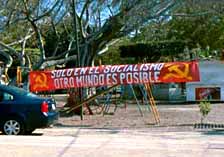 |
| Photos by Jess MacKenzie and Ernest Tate |
We bought the EZLN’s, the Communist Party’s, and the Marxist-Leninists’ publications, the last of which, incredibly, sports a picture of Stalin, and it’s not there to just illustrate an article! At that stage, our overall impression was that this was a kind of far-left event, even though there seemed to be a lot of families, across all generations, with a large number of women. Children were running around playing. Two or three hundred people sat patiently waiting for the event to begin, most of them youth. There was a festive air — people were chatting, and thirty or so from the media were waiting with their cameras. Marcos is big news in Mexico. A few police kept their distance. It was not obvious to us that there were any other Canadians or Americans present.
Click on an image for a larger view.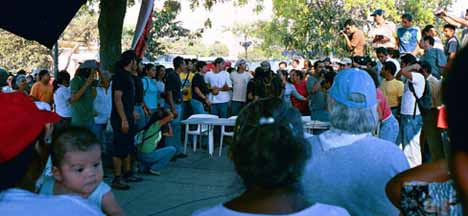 |
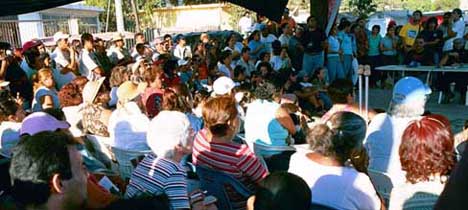 |
 |
 |
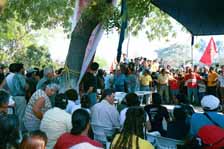 |
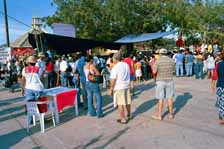 |
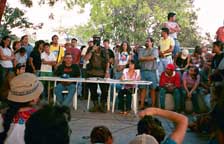 |
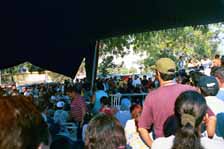 |
 Photo Courtesy of El Correo de Manzanillo |
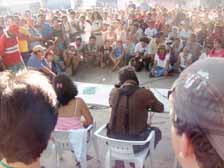 Photo Courtesy of El Correo de Manzanillo |
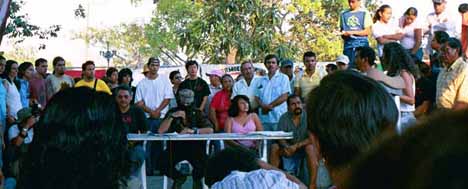 |
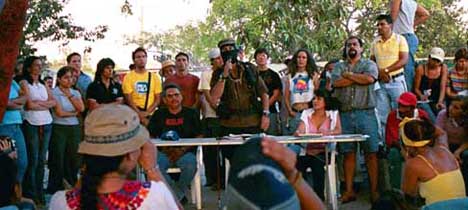 All Other Photos by Jess MacKenzie and Ernest Tate |
The EZLN leader was coming from the state capital, Colima, where he had addressed a community gathering that day. El Noticiero, the local newspaper, reported that the EZLN’s caravan would be in Campos by 4.40 p.m., and he arrived on time. The audience had grown to between 500 and 600 people, clearly an important community event. Suddenly, there was a flutter of excitement. Marcos and his comrades strode to the front. Many in the audience rushed over to greet him, crowding around his slight figure.
Before Marcos spoke, more than twenty representatives — some of them from activist groups in the community campaigning against CFE and the proposed industrial development, some from other states asking the coalition for help — addressed the gathering. For some, it was the first time they had spoken to a meeting. An objective of “La Otra Campaña” is to give the most oppressed an opportunity to express their thoughts and to listen to each other respectfully — the EZLN is to hear what they are saying. It was a very moving experience to witness this.
“For thirty years it has been a community struggle against the poisonous fumes,” a fisherman from Cuyutlán said. “Today marks the end of the process of negotiating with state institutions without receiving a response,” he warned. “We’ve decided to go into resistance.” Many of the speakers were women, who spoke simply and eloquently. A health activist spoke of the increase in cancers in the area and the general rise of respiratory illnesses among children. Several farmers told of no longer being able to grow food on what was once fertile land. The nearby lagoons, historically a rich source of fish, were in peril, a speaker from a fishers’ cooperative reported. A leader of the environmental organization, Bio Iguana, backed this up.
Many stressed that they were not in opposition to development as such, but were against development that did not take into account its impact upon the lives of the ordinary people. A woman from the community of Santiago, just north of Manzanillo, reported on the impact of the building of a new highway, which was destroying many beaches and cutting the community off from the ocean. Some large hotels are being allowed to privatize traditional public beaches, she said. A speaker from Baja California spoke of the community struggle in that state against a major natural gas pipeline and gas storage facility which was part of large project to facilitate the integration of Mexico’s energy resources into the economy of the United States. He described the destruction of fragile coastal eco-systems and the decline of the whale population which has always used Baja California as a migration route. At least two speakers, who seemed to us to be representatives from indigenous communities, were listened to very carefully and respectfully when they spoke of their own histories of resistance. The only formal political party to have a speaker on the platform was the Communist Party, which is part of the coalition.
The most dramatic speech, however, was given by David Diaz Valdez. His wife, Eduvige also spoke. She and other family members, as well as Diaz Valdez, had been arrested and suffered physical violence from the cops. The audience — even the children who until then had been running around playing — went deathly silent when Diaz Valdez stood up. Only the gentle rustle of leaves in the breeze could be heard. There was no mistaking his affiliation: he wore the red EZLN tee shirt. “We are the marginalized,” he declared in his strong voice, “we’re the last frontier fighting a bad system of government and against the destruction of our environment,” a phrase he repeated several times. He told the audience of his arrest by the police for only exercising his democratic right to protest, how they had planted drugs in his car, and how he had been tortured in the state capital, Colima, and held incommunicado in chains. He repeated a theme which ran through many of the presentations: the municipal (controlled by the National Action Party [PAN]), state, and federal authorities ignore the constitution and were violating the rights of citizens every day. “We need a new political system and a new Mexican constitution.” Many speakers attacked the state government for the sale of the nearby Juluapan lagoon to private interests and criticized the President, Vincente Fox, for the failure to carry out the promises he had made six years ago.
Many expressed their thanks and appreciation to Marcos for his help in their campaigns, a few of them handing over petitions, letters, and assorted documents to him personally, as if he was someone who could solve their problems. “We’re not surprised Marcos is the government’s enemy, just like the people were when they fought in the Revolution of 1910, just like us,” one said. A consistent theme of most the speeches was that the three levels of government constantly violated government rules and regulations and ignored the constitution in favor of the wealthy and that a new constitution was necessary for Mexico. This is one of the central demands of “La Otra Campaña.”
For two hours, Marcos sat there respectfully and patiently, listening intently, wearing a cell-phone head-set, smoking his pipe all the time, sometimes glancing at the speakers and making notes. (Some of his meetings have gone on for more than eight hours.) On each side of him were his EZLN comrades and supporters, but he was the only one wearing the signature black balaclava mask. The sight at first seemed somewhat surreal and even a little theatrical. Because of his struggles, he has become something of a folk-hero throughout Mexico. Even the government-owned tourist shops in Mexico City sells “Marcos” dolls. We thought he must have been very warm — it was around 30 degrees centigrade — but on closer examination we could see the balaclava was made from very light cotton. We also wondered how we could be sure this was the real Marcos. But the audience’s reaction to him let us know that this was the real thing, especially when he stood up to speak. There was loud welcoming applause.
Photo Courtesy of El Correo de Manzanillo
He opened his remarks by calling for peaceful and non-violent resistance, emphasizing the “need to struggle against these outrages committed by the state authorities in Colima.” He spoke to the major issues raised by the previous speakers. They are taking the land from the poor, he said, and giving it to the rich, to the large hotel owners and to industry. “And this is happening in Campos, a community which is impoverished and becoming sicker and where the arrival of progress makes only a few wealthy.” When the government speaks of progress, he said, it is not “talking about progress for the people, but for the likes of Carlos Slim, who is behind much of the buying of land and who owns businesses which are destroying communities such as Campos.” (Carlos Slim Helu, a Mexican mogul, is the world’s third richest man, with $28.8 U.S. billion, according to Forbes.) Speaking of the proposed “regasification” facility at the new port on Cuyutlán lagoon, Marcos said he was making what he hoped wouldn’t be “a terrible prophecy,” that the large gas tanker ships would bring many more problems to the community such as drugs and prostitution.
He criticized the building of luxury hotels for the tourist industry right here in Manzanillo, some charging over $1,000 a night in the midst of a housing crises, when many people cannot afford even a modest place to live. He called for the defeat of the government (we assume he meant the Federal) — without specifying what would take its place — and for the elaboration of a new constitution. “The government is at the service of a system which we want to destroy; when they speak of progress and development, we have to ask for whom?” You should ask yourselves whether you are better off than before, he said. If the answer is no, you should all rise up, all at the same time, and defeat the government, “because this movement is not only a movement confined to Chiapas or Colima, but a movement of the whole country.” With “another government,” Campos could return again to being a producer of fruit and vegetables, not the sickness of cancer.
What was remarkable to us was that there was no reference to any of the major three candidates in the current presidential campaign, neither in the remarks of any of the earlier speakers nor by Marcos! “Every three years, every six years they come to sell us the same lie,” he stated, “they have nothing to give us, and there is nothing of use to us that we won’t build ourselves with our own strength. Things will only change from below and from the left.” If politics at the level of the Mexican state was referred to at all, it seemed to be in a completely abstract way, such as, “we need a new political system,” unless, of course, our Spanish is not up to the task of detecting such subtleties. The “La Otra Campaña” seems to be completely extra-parliamentary in its focus. The only practical measure proposed at the Campos rally was that the community should continue with their resistance and even intensify it. We asked ourselves whether we were seeing an application of John Holloway’s ideas from his “Changing the World without Taking Power.” But this would be too easy an explanation.
The EZLN must realize that their demand, for example, for a new Mexican constitution, poses the question of power and raises the question of how this demand will be achieved. It’s obvious a political organization of some kind will have to be created to win control of government to attain this. And activism alone on ecological issues will not put a stop to Mexico’s environmental degradation. Some on the left inside and outside Mexico, from day one, have criticized the EZLN for not building a revolutionary party to struggle for socialism. But this criticism may be, to say the least, far too premature. While the Sixth Declaration makes a withering criticism of the big capitalist parties, it’s not against political parties as such and leaves that door open. The EZLN seems to be going through a process of change from being essentially an armed-struggle movement, an “army,” to becoming a political organization of some kind, and Holloway may be over-generalizing from what is but a moment in the history of its evolution.
However, if it’s a political party which comes out of all this, it will probably be quite different from anything we’ve seen before, obviously shaped by the experience in Chiapas. But there’s no doubt the EZLN’s present “non-political” line will give them some difficulties in the current conjuncture because many activists will be swept up into electoral politics behind López Obrador. The old notion that politics abhors a vacuum applies here. Already a key veteran of the C.P., Armando Martinez Verdugo, has broken ranks. But the evidence suggests the EZLN is not thinking in the short-term but maybe of the next “Sixeno.” We prefer to see it as being in the process of consolidating its forces and supporters outside its base in Chiapas. They are a mass phenomenon. Their powerful hard-won position as the voice of Mexico’s most oppressed, the 10,000,000 indigenous and the poor, combined with their strong opposition to environmental degradation as seen in Campos, has placed them in a key strategic position to lead in a genuine recomposition of the Mexican left. Marcos seems to hope they will eventually win over those social activists who are now supporting López Obrador but who will eventually be disappointed by him, to help in the building of an effective mass political force capable of fundamentally changing Mexico.
As we were leaving Manzanillo to head back to Toronto, we noticed the headlines in El Noticiero: the local authorities had put a halt — we don’t know for how long — to Zeta Gas’s construction project until a review of its safety, of whether or not it conformed to regulations, takes place. Apparently, a large barge had gone aground which raised security concerns. We couldn’t help but make the connection between this stoppage and Marcos’ visit to the Mexican “Riviera.” And we’re sure the political activists we had heard in Campos thought likewise.
NOTES
The Mexican Election Campaign
The country is getting ready to vote on July 2nd. Much of the Mexican press is saying that Andrés Manuel López Obrador, the Partido de la Revolución Democrática (PRD) candidate and the ex-mayor of Mexico City, has a good chance of winning and that Mexico will become part of the trend sweeping many parts of Latin America and move to the left. As this point, it’s unclear how far to the left, but it certainly seems large parts of the ruling class think it will be too far. López Obrador, who has been ahead in the polls for the last three years, and who on March 30th had a lead of as much as 9% in some polls, has seen his lead begin to narrow. The current President, the neo-liberal Vicente Fox, and his right-wing PAN, together with the Institutional Revolutionary Party (PRI), which had ruled Mexico for 71 years before Fox, are engaged in a massive effort to discredit López Obrador through vicious red-baiting.
Features of Mexican “La Otra Campaña”
(From the letter of invitation, sent by Subcomandante Marcos to the “La Otra Campaña” plenary gathering, September 2005.)
For a National Plan of Struggle and a new Mexican constitution; for civilian and peaceful methods; national and anti-capitalist; recognizing the limits of single issue activities and seeing the need to combine with other struggles; an understanding of and assistance to all struggles on behalf of humanity and against world-wide neoliberalism; left-wing, another kind of politics; favoring listening and getting to know the struggles and the fight-backs that are presently taking place around the country; being in solidarity with these struggles, helping them and learning from them; respecting organizations’, groups’, collectives’, and individuals’ work methods, decision-making, demands, strategies, and tactics; always basing ourselves on mutual respect, linking struggles and organizations.
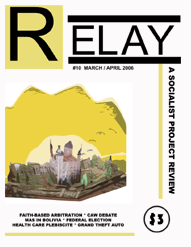
Among articles and translations by MacKenzie and Tate available online are “The Scottish Socialist Party Continues to Amaze: A Report on the 2004 Annual Conference in Edinburgh” (Relay August/September 2004); and “An Alliance with the PL and PMDB Is a Waste of Time: An Interview with Raul Pont” (International Viewpoint 343, September 2002).

